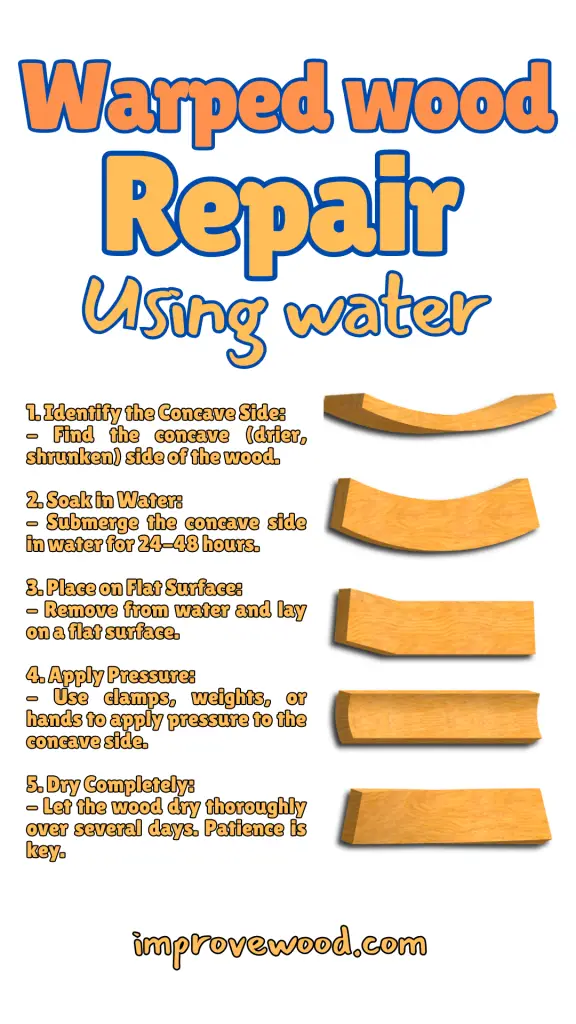Wood is a versatile and popular material used in various woodworking projects. However, over time, wood can become warped or twisted, which can affect its functionality and aesthetics. Fortunately, there are techniques available to straighten wood and restore its original shape. One such method is using water to relieve tension and reshape the wood fibers. In this article, we will explore the process of straightening wood with water and provide additional methods to tackle warped wood effectively.
How Water Affects Wood: Understanding the Science
Wood, as a hygroscopic material, has the ability to absorb and release moisture from its surroundings. This process is influenced by factors such as wood type, moisture content, and relative humidity. When wood absorbs water, its fibers begin to swell, which can lead to warping, cupping, or bowing, depending on the severity of the moisture imbalance and the wood species involved.
Utilizing Water

Interestingly, the same swelling effect caused by water absorption can be harnessed to straighten warped wood. By introducing moisture, the concave side of the wood undergoes expansion, effectively relieving tension and allowing the wood to regain its flat shape.
The amount of water required for straightening depends on the severity of the warp. Generally, more severe warps necessitate greater water absorption. It is crucial to note that using water as a straightening method provides a temporary solution. As the wood dries out, the warp may gradually return. Nonetheless, employing water can be a practical approach when temporary straightening is needed for a specific period.
How to Straighten Wood with Water
1. Identify the concave side of the warped wood:
Before starting the straightening process, it is crucial to determine the concave side of the wood. This side is typically drier and has shrunk, contributing to the wood’s warping. Identifying this side will help you apply the correct treatment.
2. Soak the concave side in water:
Once you’ve identified the concave side, it’s time to introduce moisture to the wood. Submerge the concave side in water, using a bucket, tub, or sink. Ensure that the water completely covers the affected area. Let the wood soak for approximately 24 to 48 hours, allowing the water to penetrate the fibers.
3. Remove the wood from water and place it on a flat surface:
After the soaking period, carefully remove the wood from the water. Place it on a flat surface, such as a workbench or a level floor. This will provide a stable foundation for the straightening process.
4. Apply pressure to the concave side:
To straighten the wood, apply pressure to the concave side. This can be done using clamps, weights, or even your hands. The pressure will help the wood fibers regain their original shape while drying.
5. Allow the wood to dry completely:
Once you’ve applied pressure, it’s important to let the wood dry completely. This process may take several days, depending on factors like wood thickness and ambient humidity levels. Patience is key during this step to achieve the desired results.
Tips for straightening wood with water:
- Use warm water: Warm water will facilitate quicker penetration into the wood fibers.
- Avoid excessive soaking: Prolonged soaking can cause over-swelling and distort the wood. Stick to the recommended 24-48 hour soaking time.
- Apply pressure evenly: Ensure that the pressure is distributed evenly across the concave side to avoid cracking or further damage.
- Exercise patience: Remember that wood drying takes time, so be patient and allow the wood to dry thoroughly before removing the pressure.
Additional methods for straightening warped wood:
- Steaming: Utilize steam to penetrate the wood fibers more quickly. Steam can be applied using a steam iron or a steamer on the concave side of the wood.
- Clamping: Apply pressure using clamps to straighten the wood. This method is effective, but be cautious not to exert excessive force that may damage the wood.
- Heat: Apply heat to the concave side of the wood to expand the wood fibers. Use a heat gun or a hairdryer to gently heat the wood and encourage it to regain its original shape.
Conclusion: How to Straighten Wood with Water
Straightening warped wood is a valuable skill for woodworkers and enthusiasts alike. By using water, steam, clamps, or heat, you can successfully restore wood to its desired form. Remember to identify the concave side, soak the wood appropriately, apply pressure evenly, and exercise patience during the drying process. If unsure about the best method for your specific wood or project, seeking advice from an experienced woodworker is recommended. With the right techniques and care, you can bring back the beauty and functionality of your warped wood projects.

